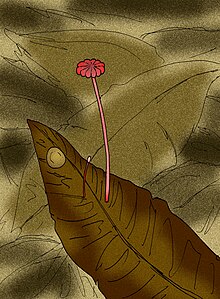| Archaeomarasmius Temporal range:
| |
|---|---|

| |
| Artist's reconstruction | |
| Scientific classification | |
| Domain: | Eukaryota |
| Kingdom: | Fungi |
| Division: | Basidiomycota |
| Class: | Agaricomycetes |
| Order: | Agaricales |
| Family: | Tricholomataceae |
| Genus: | †Archaeomarasmius Hibbett, Grimaldi & Donoghue |
| Species: | †A. leggetti
|
| Binomial name | |
| †Archaeomarasmius leggetti | |
Archaeomarasmius is an extinct genus of gilled fungus in the Agaricales family Tricholomataceae, containing the single species Archaeomarasmius leggetti. It is known from two fruit bodies recovered from amber, one consisting of a complete cap with a broken stem, the other consisting of a fragment of a cap. The cap has a diameter ranging from 3.2 to 6 mm (0.13 to 0.24 in), while the stem is 0.5 mm (0.02 in) thick. Spores were also recovered from the amber, and are broadly ellipsoid to egg-shaped, measuring roughly 7.3 by 4.7 μm. The species, which resembles the extant genera Marasmius and Marasmiellus, is inferred to have been saprobic on plant litter or other forest debris.
The genus is solely known from the New Jersey amber deposits along the Atlantic coastal plain in New Jersey, United States, which date from the Turonian stage (about 90–94 Mya) of the Upper Cretaceous.[1] Archaeomarasmius is one of only five known agaric fungus species known in the fossil record, and the only one to be described from New Jersey amber.